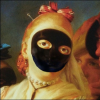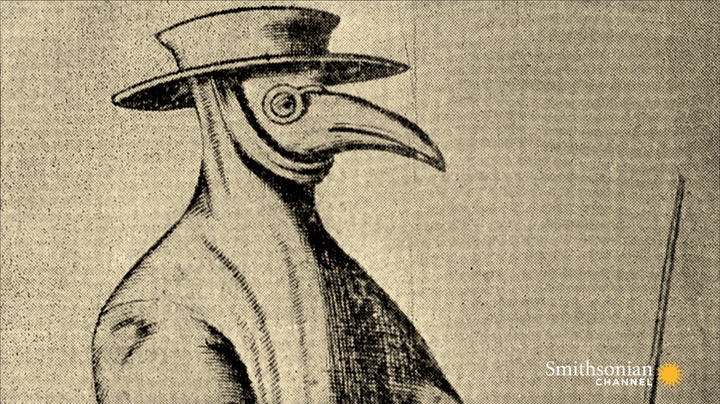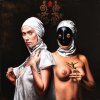Oh you need l'bogo to tell you about masks like il Medico della Peste,
(that's what his CF name means in Veneziana, 'the mask'),
I learnt a whole lot about Venetian carnival masks and their mystic meanings
when working with him on Notturno Veneziano
The traditional Venetian masks
Do you think that Venetian people only wore masks at carnival? If it were true, how could have been possible for Venetian masks to be so strongly present in the Venetian tradition? We can see them painted by the most important Venetian artists: Pietro Longhi, Canaletto, Tiepolo and Francesco Guardi.
The truth is that in Venice masks were a real habit and not a simple carnival trick… Or at least not only that. During the whole year Venetian people could wear a mask, apart from certain days during Advent and Lent.
The dark side of carnival: the Doctor of the Plague mask

The
Doctor of the Plague, with his bird beak, his hooked nib full of medicinal substances, who wears glasses, gloves, a long pure linen robe and holds a wand, is not a proper carnival mask. It was created by doctor Charles De Lorme, witness of the dramatic plague of 1630 in Venice, with the naive hope that it would be enough to protect people from the miasmas and the deathly threat of the epidemic.
Now at carnival it is used to emphasize feelings: mixing suffering with joy, defeating the danger for good, the great bird will protect the
Serenissima under its protective wings.
The plague in Venice
Every year, the third Sunday of July, Venice celebrates the Redentore day. It is a such an important day that it is celebrated with a parade of boats and wonderful fireworks in front of the Redentore Church, on the Giudecca island. After more than five centuries it stills celebrates the victory over one of the most terrible calamities that happened to the city: the plague.
Several times over the centuries this epidemic decimated Venetian citizens, with the most terrible infections in 1575-1577 and 1630-1631. On both occasions the Senate and the patriarch Giovanni Tiepolo, feeling impotent in the middle of the massacre, decided to ask God to save the city, promising that in return they would build a church each. The first is the Redentore Church, the second the Santa Maria della Salute Basilica.
These episodes show how terrible the plague was, a real despairing illness for a time when
no cure was possible because its causes would be discovered only in the 19th century. “Plague” is a synonym of destruction and brings about terror in the Middle Ages and the modern era. For this reason the Doctor of the Plague mask is so disturbing: it is one of the death’s disguises.
How does the Doctor of the Plague mask looks like
This mask was meant to be a real armour which, according to Charles de Lorme, was supposed to protect doctors from the infection.
This is the reason why the linen or waxed canvas robes cover the doctor’s whole body, while his hands and head are protected by gloves and a hat. The origins of this costume also explain the shape of the mask: the
hooked beak contained the scented herbs and, usually, a sponge drenched in vinegar that were thought would clean the air.
The unhealthy air was considered to be the cause of the disease, that is why herbs and balsamic substances were thought to save the doctors. No one thought that malnutrition and the dreadful sanitary conditions would be the cause of the disease. Being the causes unknown, the doctor of the plague could not do much: this is why he is not associated to the entertaining side of carnival but with its most serious and dark component, which, by the way, permeates any foolishness of these days of the year.
A daily mystery: the Bauta

The
Bautta is the Venetian costume par excellence. Lorenzetti defines it as a “common way of dressing” more than a real costume, which was worn both by men and by women who belonged to any social class. The Bauta always looked the same; therefore, it was not unusual to find “the noblest with the humblest people and with the finks of the greatest renown”.
The story of the Bautta
The
Bauta achieved the greatest success between the 17th and the 18th century, even if its origins are much older: we find the
first proof of its existence in the 13th century, and it remained popular until the end of the Venetian Republic, at the end of the 18th century. Its huge success was due to the particular role that costumes had in Venice, but also to its extreme comfort and the tolerance that people felt towards it.
More than any other Venetian costumes, the
Bauta was actually allowed to wander around the streets and squares: even during the Saint Mark and Ascension days, or when the
Dogi and the attorneys were elected, when people wearing costumes were normally not allowed. And there is more: since the costume is, par excellence, the way of becoming someone else, it was not only noble people who had the right to wear one, but even people from the less rich social classes. And women. Let’s discover why.
What is the Bautta?
Behüten. “To protect”: the word “Bauta” comes from this German verb. An extremely appropriate word because the
Bauta is a real costume that, as its name says, protects those who wear it from other people’s eyes. The same eyes that would like to reveal the identity of the
siora mascara (the mask), but can’t: the
tabarro and the cape, both black, cover the whole body apart from the face, and on the head there is a flabby hat, usually black and with two or three horns (bi-tricorne).
It could seem like a simple costume, almost spare, but it is not: the cape can be made of silk, velvet or lace; the mask is made of silk, velvet or cardboard, painted in white or black. It was made of different materials, therefore, according to the person who bought it, even if the different parts did not change, as well as the shape of the mask, called “
volto”, or “
larva”.
Larva: once more, it is not a casual word, since “larva” in Latin means “theatre mask”, but also “ghost”, which disquiets and torments living people; it is a very mysterious name that defines a full of secrets mask. However, it was also very handy: the beak shaped lower part allows eating and drinking without removing it, apart from changing the person’s voice. To conclude, a complete costume to become someone else, to mix with the aristocracy and to set free someone’s lust for freedom.
The fascinating silence: the Moretta

A mysterious appearance whose disquieting silence creates certain expectations: it may be the secret of the
Moretta. According to tradition, it has to be put in front of the face by holding a button with the teeth. As many decorations in the past, this mask was introduced from France and became a fancy accessory for female dresses.
When and why is the Moretta used?
The secret for the success of the “dumb maid-servant” is its shape: small and made of black velvet, it enhances the
features of women’s faces and their light complexion, characteristic that makes it immediately very popular in Venice. Moreover, its popularity was further helped by the opportunities offered to women.
One of the first situations in which it came in handy was when women went to visit nuns: with their heads covered by veils or by a
xendal, a taffeta shawl or, later on, a lace one, Venetian women used to walk silently towards convents. Anyway, the Moretta also had another function, let’s say a less pious one.
At carnival, bizarre things are very common and there were small buildings, called “casotti”, where Venetian people could admire – paying a fee, of course – the wonders of the world, mainly from the new world. Lions, elephants and all kinds of exotic animals appeared in Venice, charming the audience with tightrope walkers and magicians. In order to visit these places full of wonders, humble, bourgeois or noble women hid their faces behind a Moretta,
Was it because they did not want to be recognized and, therefore, lose their reputation? Of course, but also in order to look around and find their “prey”.
The Moretta is, actually, also a
flirting tool, which makes the woman intriguing and full of secrets. While preventing her from talking, it offers her the chance to decide who to talk to and, thus, to reveal her face and feelings. But only to the person she chooses.
Gnaga: the cat mask

You’ve been seeing it for ages, but do you know where it comes from? The cat mask’s history in Venetian tradition will astonish you, because it’s something incredible.
The ancient origins of the cat symbol
Maybe it’s
Ancient Egypt, where cats were literally worshipped, where the meaning of the Gnaga is rooted in. Egypt was, indeed, the reign Bastet watched over, the cat-goddess of love, health, motherhood… and earthly joys.
Just to make things clear as to which earthly joys we’re referring to, let’s jump ahead a few thousand years, and see what was going on in
Venice in the 16th century.
In 1509, the city of the Bosom Bridge and Street boasted no less than 11.164 prostitutes – out of a population of around 150.000 people -, who were though facing a crisis so serious that they had no other choice but to appeal to the Patriarch of Venice, Antonio Contarini. The government didn’t delay in taking measures, since customers were stolen from them… by male prostitutes.
To save themselves from the dreadful death they were sentenced to if caught, hung in St. Mark’s little square and then burnt to ashes, male prostitutes had just one solution: masks.
The cat mask
Maybe honouring what the goddess Bastet, in her times, stood for, or rather because it allowed men to dress like women, homosexuals resorted to the
Gnaga to walk down the streets undisturbed. Thanks to a loophole in Venetian law itself.
Who was wearing a mask, indeed, could not be arrested: he, or she, was a mask and therefore playing a role. That’s why Gnagas could mock passers-by, even in an obscene way, in a shrill tone which was similar to a woman’s voice, or to a cat’s meow. And “meow” is gnau in Venetian dialect, then the mask is probably named after this sound.
In order to try and reduce the cutthroat competition with these fierce contestants, the government declared, so to say, to “open shop windows” above Bosom Bridge (
Ponte delle Tette) and on Bosom Street (
Fondamenta delle Tette). Now take a guess at why they’re called so.







































